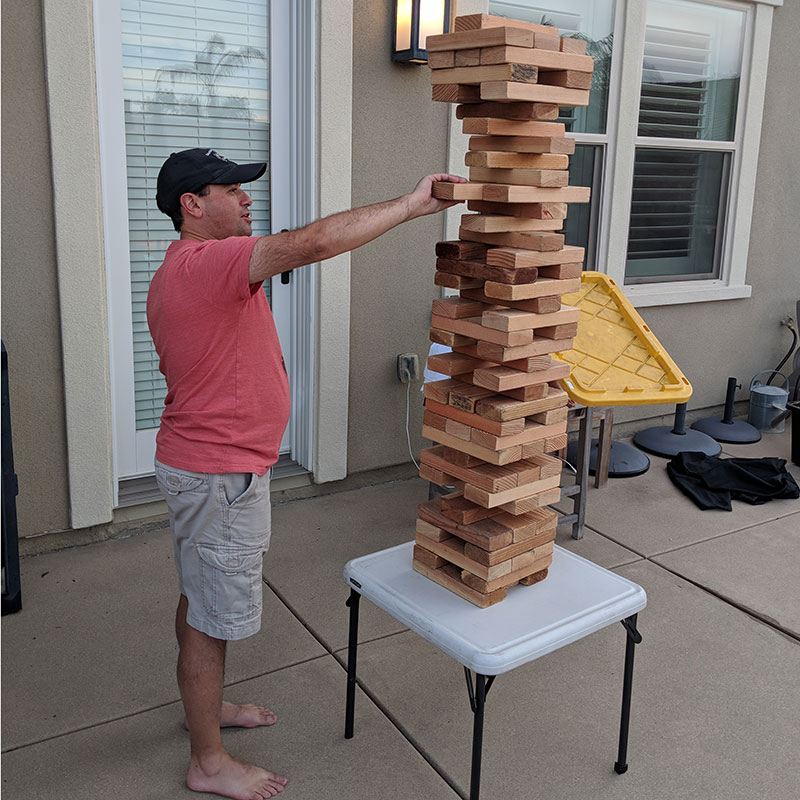

Rotational Force and the Jenga® GIANT™ game These concepts are used by structural engineers to establish the building´s strengths and weaknesses the same you can use them to create a fantastic strategy to win the game. In this case, your Jenga® GIANT™ hardwood game is the perfect material since the towers don’t get tall enough or heavy enough to be compressed or tensed to the point of splitting. Tensile strength refers to the maximum force that can be applied before a material is pulled apart. Another thing to consider is the materials used to achieve tensile strength. When you remove a middle block from your Jenga® GIANT™ tower, the remaining layers experience both tension from the layers below and compression from the rest of the blocks on top. Tension refers to the force applied when an object is pulled or stretched. Compression refers to the force applied when two objects are pushed together. Tension and Compression are two concepts that can be put to the test while playing with your Jenga® GIANT™ game. Tension, Compression and the Jenga® GIANT™ game By choosing the foundation to play your Jenga® GIANT™ game, you are applying structural engineering tips to keep the tower from crashing down! 3. Foundations help transfer the load of the structure to the ground and also help anchor the structure. If you construct a tall building in loose soil, it will likely collapse, create cracks on the walls, or come crashing down in the midst of an earthquake. When building a structure, engineers also have to take into account the foundation surface, since the same principle applies as for your Jenga® GIANT™ game. Finding the right table is essential since bumps or unevenness can destabilize your tower. When playing the Jenga® GIANT™ game, the surface is as important as the game. Playing with the Jenga® GIANT™ game can help you understand the importance of loading when designing a building.

To design a building, engineers have to consider a load path from the top to the bottom of the building. When playing with your Jenga® GIANT™ game, understanding which are load pieces will help you to keep the tower from crashing on your turn. Therefore, they are not structurally important for the tower at the moment they are pulled or pushed from the tower.

These “loose” pieces are not load-bearing pieces. One of the main strategies when playing with your Jenga® GIANT™ game is locating the loose blocks to remove with ease without toppling the tower. In your Jenga® GIANT™ game, no two blocks are cut to exactly the same dimensions or have exactly the same weight, which makes the loading vary across the tower. Loading refers to the idea that a part of a structure supports the weight of another part or the rest of the structure. Use your Jenga® GIANT™ game to learn these structural engineering tips and take your strategy to the next level. Discover five structural engineering tips that make your Jenga® GIANT™ game more than a game! Discover five structural engineering tips with your Jenga® GIANT™ game Children from a very young age are tiny “engineers” when playing with their Jenga® GIANT™. Therefore, the principles are pretty much the same. Buildings are very much like Jenga® towers. When you think that playing with your Jenga® GIANT™ game cannot get any better, you discover that it can also demonstrate basic concepts about gravity, physics, and even earthquakes as you try to avoid having the tower of blocks crash. This means that while playing, you can learn and put into practice certain aspects of structural engineering. Its main objective is to maintain a structurally sound tower as you take blocks off and put them on top. However, the Jenga® GIANT™ game is much more than just a game. It is an amazing way to help children build structures. The original Jenga® game was created by Leslie Scott and her family while they were living in Africa, and it was launched at the U.K.


 0 kommentar(er)
0 kommentar(er)
